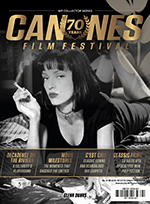 Glenn here. Each Tuesday we bring you reviews and features on documentaries from theatres, festivals, and on demand. In celebration of not just the Cannes Film Festival, which launches this week, but also the release of my book Cannes Film Festival: 70 Years out now through Wilkinson Publishing, we're looking at the first documentary to win the Palme d'Or. The book is a glossy trip through history, looking at the festival's beginnings, the films, the moviestars, the fashions and the controversies. You better believe I convinced my editors on a double-page Nicole Kidman spread!
Glenn here. Each Tuesday we bring you reviews and features on documentaries from theatres, festivals, and on demand. In celebration of not just the Cannes Film Festival, which launches this week, but also the release of my book Cannes Film Festival: 70 Years out now through Wilkinson Publishing, we're looking at the first documentary to win the Palme d'Or. The book is a glossy trip through history, looking at the festival's beginnings, the films, the moviestars, the fashions and the controversies. You better believe I convinced my editors on a double-page Nicole Kidman spread!
Despite the belief that documentaries are as rare among the Cannes line-up as rain in the desert, the Cannes selectors of old were particularly fond of them. Especially so through the 1950s and 1960s. That just happens to be where we find the first documentary winner of the Palme d’or, The Silent World, or Le monde du Silence.
The documentary is a collaboration between explorer Jacques Cousteau and a pre-fame Louis Malle, who was just 23 years old at the time and was only two years away from delivering the noir masterpiece (so says me) Elevator to the Gallows. In The Silent World, Cousteau and Malle are able to capture images of natural wonder that 60 years later continue to thrill and take the breath away and sing with poignancy while putting our place among nature into perspective. More after the jump...

It’s hard to pick just a single favorite moment, but it’s hard to go past the three-minute porpoise run that is so well-paired with Yves Baudrier’s music it recalls a later Palme d’Or winner – Francis Ford Coppola’s Apocalypse Now and the "Ride of the Valkyries". Elsewhere, I found the way Malle and Cousteau’s camera capture a shipwreck beautifully suggests the way a tragedy can become a refuge quite haunting. The circle of life under the sea.
 Away from the nature itself, I was particularly enraptured by the opening image of scuba divers – “space men of the sea” according to some promotional materials of the day – plunging through the ocean with phosphorous torches, leaving a trail of bubbles and gas behind them. It’s an arresting opening image, and one that in retrospect suggests some of the film’s more destructive elements at the hands of its human subjects to come later in the film. The less said about the comical and haphazardly handled recreations of dramatic moments not caught on film, however, the better.
Away from the nature itself, I was particularly enraptured by the opening image of scuba divers – “space men of the sea” according to some promotional materials of the day – plunging through the ocean with phosphorous torches, leaving a trail of bubbles and gas behind them. It’s an arresting opening image, and one that in retrospect suggests some of the film’s more destructive elements at the hands of its human subjects to come later in the film. The less said about the comical and haphazardly handled recreations of dramatic moments not caught on film, however, the better.
But, on the flip side, you can't ignore the alarming tactics like the infamous shark cull whale (referenced on the poster) or the dynamiting of a reef which make Cousteau’s crew look like open sea thugs dredging up excitement in the death of animals. These methods continue to raise controversy in France as recently as last year when Gerard Mordillat labelled Cousteau as “the worst kind of butcher” and saying that of the acts portrayed film that “it’s horrible, it’s repulsive, it’s something unbearable.” Hopefully watching the film today highlight the fact that as research has progressed there is no need for governments to now mimic these destructive practices in the hunt for profits.
The Silent World’s place in film history is particularly interesting to me and it’s fitting that it was the first documentary – and the only one for 40+ years – to win Cannes’ major prize given nature documentaries were the medium’s most popular form of the era. With the help of television, audiences of the post-war boom were keen to see more of the world and pioneering cameras and filmmaking techniques made nature a perfect and popular subject matter for documentarians at a time when recreational international travel was exclusively a privilege of the wealthy, and when even visiting the then expanding national parks system could be costly. Films like The Silent World (and other Cousteau works) were no doubt the first encounter many viewers had with nature of this kind and conservation and for that, along with the simple beauty of its craft, it remains an important work of cinema.
Cannes Film Festival: 70 Years is available across Australia, as well as online, and through both Barnes & Noble and Books a Million in the USA.